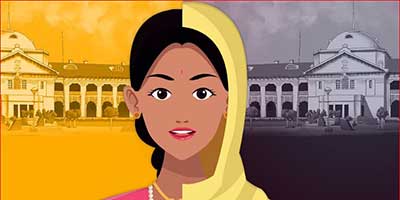Date: 16/11/2022
Relevance: GS-2: Structure, organization and functioning of the Executive and the Judiciary.
Key Phrases: religious conversions, Meenakshipuram conversions, social discrimination, Article 25, love jihad, IPC provisions, judicious intervention, propagate religion.
Why in News?
- Over the last few years, religious conversion has become a politically fraught issue.
- While hearing a PIL on religious conversion, the Supreme Court said that “forced” religious conversions are “very dangerous” and may “ultimately affect the security of the nation as well as the freedom of religion and conscience of the citizens”.
Background of Anti Conversion Laws:
- Princely states headed by Hindu royal families were the first to introduce laws restricting religious conversions during the British colonial era, especially during the latter half of the 1930s and 1940s.
- Madhya Pradesh, Uttar Pradesh and Himachal Pradesh passed anti-conversion laws that outlaw religious conversion solely for the purpose of marriage.
- Uttar Pradesh Prohibition of Unlawful Conversion of Religious Ordinance, 2020 also requires a 60-days-notice. However, it also requires the Magistrate to conduct police inquiry to ascertain the real intention behind the conversion
- Under the MP law, the burden of proving that the conversion was done in a legitimate fashion lies with the person converted.
- Under the MP law, any marriage where a husband or wife has converted (even consensually) will be declared null and void unless prior notice is given to the state government.
- Karnataka law says any person intending to convert to another religion after the law comes into force will have to notify the district magistrate two months in advance.
Do you know?
- Mass conversions in independent India, though rare, have been acts of protest against social discrimination.
- The conversion of BR Ambedkar and over three lakh followers, mostly Dalits, to Buddhism in 1956 as well as the 1982 Meenakshipuram conversions, when 180 Dalit families in a Tamil Nadu village embraced Islam, were acts of political revolt.
Key Highlights:
- The bench urged the government to “make their stand clear and file counter on what steps can be taken by Union and/or others to curb such forced conversion, maybe by force, allurement or fraudulent means”.
- When the court singles out the issue for its attention, asks what action the government proposes to take, it implies both that “forced” religious conversions are a significant problem and that existing laws are insufficient to deal with it.
- Article 25 of the Constitution says “all persons are equally entitled to freedom of conscience and the right freely to profess, practise and propagate religion”.
- But at least 10 states have legislated anti-conversion laws, beginning in the 1960s.
- The claim is that legal safeguards, including IPC provisions, have failed to stop religious conversions through “coercion”, “intimidation”, “allurement”, “threats”. However, these are loosely worded terms prone to misinterpretation.
- The current context of the conversion debate appears to be missionary activity in tribal areas and inter-religious marriages, labelled as “love jihad”.
Judicial pronouncements on such laws
- Salamat Ansari- Priyanka Kharwar case of Allahabad High Court 2020: The right to choose a partner or live with a person of choice was part of a citizen’s fundamental right to life and liberty (Article 21).
- Hadiya Case: Matters of dress and of food, of ideas and ideologies, of love and partnership, are within the central aspects of identity. Neither state nor the law can dictate a choice of partners or limit the free ability of every person decide on these matters
- K.S. Puttuswamy case: The autonomy of the individual is the ability to make decisions in vital matters of concern to life. Any interference by the state in an adult’s right to love and marry has a “chilling effect” on freedoms.Intimacies of marriages exist within a core zone of privacy, which is inviolable.
- The Uttarakhand HC, in November 2017, held that conversions for the sake of marriage “a sham” and urged the government to enact the law against such conversions. This became the basis for the Uttarakhand Freedom of Religion Act, 2018.
- Sarla Mudgal case: The court had held that the religious conversion into Islam by a person from non-Islamic faith is not valid if the conversion is done for the purpose of polygamy.
Way Forward:
- Anti-conversion laws must be backed by a concrete study on the ground-realty of forced conversions.
- At the same time, it is the duty of the state to enable and facilitate inter-faith/inter-caste marriages.
- State while enacting anti-conversion laws should also respect their Freedom to get convert and should not put any vague or ambiguous provisions for the person who wanted to convert of his own will.
- Awareness to the people: People also need to be educated about the provisions and ways of Forceful conversions, Inducement or allurement etc.
- There is a need for uniformity: Article 18 of the Universal Declaration on Human Rights mentions everyone has the right to freedom of religion including changing their faith. Since it is a state subject, the Centre can frame a model law like Model law on contract farming etc.
Conclusion:
- The judiciary can do well by putting forth the principle that every citizen is free to take actions that are not harmful to oneself and others.
- However, the bar for action against “fraudulent” conversions has to be set high so that it does not interfere with fundamental freedoms.
- A judicial and judicious intervention on religious conversion must be mindful of the context, avoid vague terminology and carefully sidestep prejudice.
Source: Indian Express
Mains Question:
Q. “Forced” religious conversions are “very dangerous” and may “ultimately affect the security of the nation as well as the freedom of religion and conscience of the citizens”. Critically analyse the statement. (250 Words).








